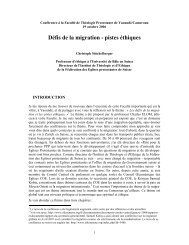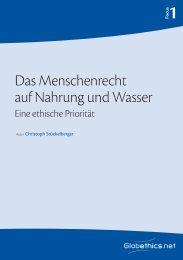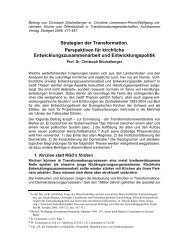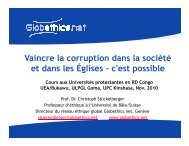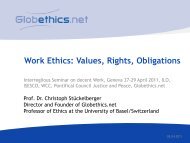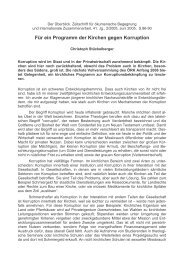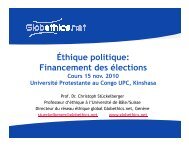BREAK THE CHAINS OF OPPRESION AND THE YOKE OF ...
BREAK THE CHAINS OF OPPRESION AND THE YOKE OF ...
BREAK THE CHAINS OF OPPRESION AND THE YOKE OF ...
You also want an ePaper? Increase the reach of your titles
YUMPU automatically turns print PDFs into web optimized ePapers that Google loves.
study 5 of children’s attitudes to prostitution among pupils of the 2 nd , 6 th and 9 th<br />
classes at elementary schools in Prague and Cheb. 42% of the children questioned<br />
in Cheb characterised prostitution as a possibility of earning for people<br />
without an education. In Prague by contrast it was 4,6 of the children 6 .<br />
This result is alarming. In areas with a shortage of jobs and high unemployment,<br />
where the prospects for personal development are poor and prostitution generally<br />
widespread, the population can regard prostitution with tolerance or indeed<br />
benevolence. The boundaries between what is desirable, tolerable or inacceptable<br />
are visibly displaced. In socially weak families and areas where the demand for<br />
sexual services is relatively strong, children can respond to the pressure of their<br />
social surroundings (including the people closest to them) and consumers and so<br />
fall prey to pimps and human traffickers. Accordingly poor future prospects and<br />
unstable family relations play a dominant role in child prostitution and child<br />
trafficking. Although this connexion does not look much different in the case of<br />
children and young people compared with adult victims of human trafficking, a<br />
further boundary is crossed here: the vulnerability of children who have no<br />
choice is exploited in extremely degrading fashion. At this point the instruments<br />
of criminal law are challenged in a special way.<br />
The Roma<br />
EXPLoita Tion<br />
In connexion with human trafficking in border regions it is necessary to give<br />
particular attention to the so-called Roma question. Because of the fact that<br />
there are no statistics for the Czech Roma, statements about their numerical<br />
presence in the scenes of prostitution and child prostitution are speculative. The<br />
starting point for �further �reflection � can therefore �only �be<br />
such experienced data<br />
as are based on local observations. Representatives of local social services report<br />
on entire living areas and whole communities where Roma clans live, for example<br />
in the regions of West Bohemia, Chomutov or by Teplice. There are areas<br />
here which are exclusively inhabited by socially marginalised population groups.<br />
A range of these Roma families live from the prostitution of their very young<br />
women, who in part can be under 18 years old, in some cases even much<br />
younger. In this opaque environment child prostitution is on offer. Admittedly<br />
this criminal market operates under cover, because it is also strongly bound up<br />
with blackmail of the customers of the under-age prostitutes. This problematic<br />
situation is the result of a completely failed attempt to reintegrate the Roma in<br />
the Czech Republic in the second half of the twentieth century. The Roma were<br />
uprooted from their traditional life-style without being offered alternative mod-<br />
5 Eva Vaníčková, Dětská prostituce, Prague 2005, 2 2007, Grada.<br />
6 1585 children were questioned; they were asked 23 questions.<br />
������������������������������������������������<br />
� � � � ������������������������� �<br />
134<br />
– IN <strong>THE</strong> MIDDLE <strong>OF</strong> EUROPE –



